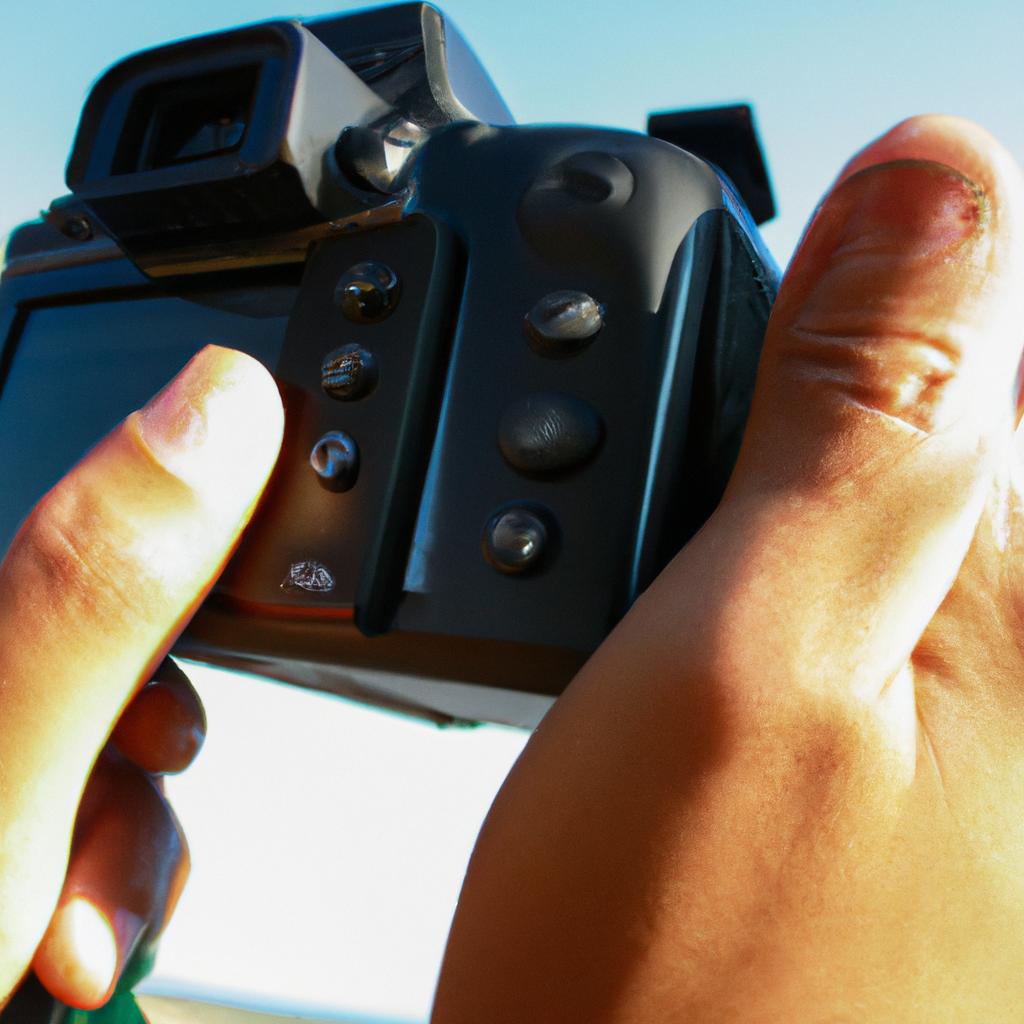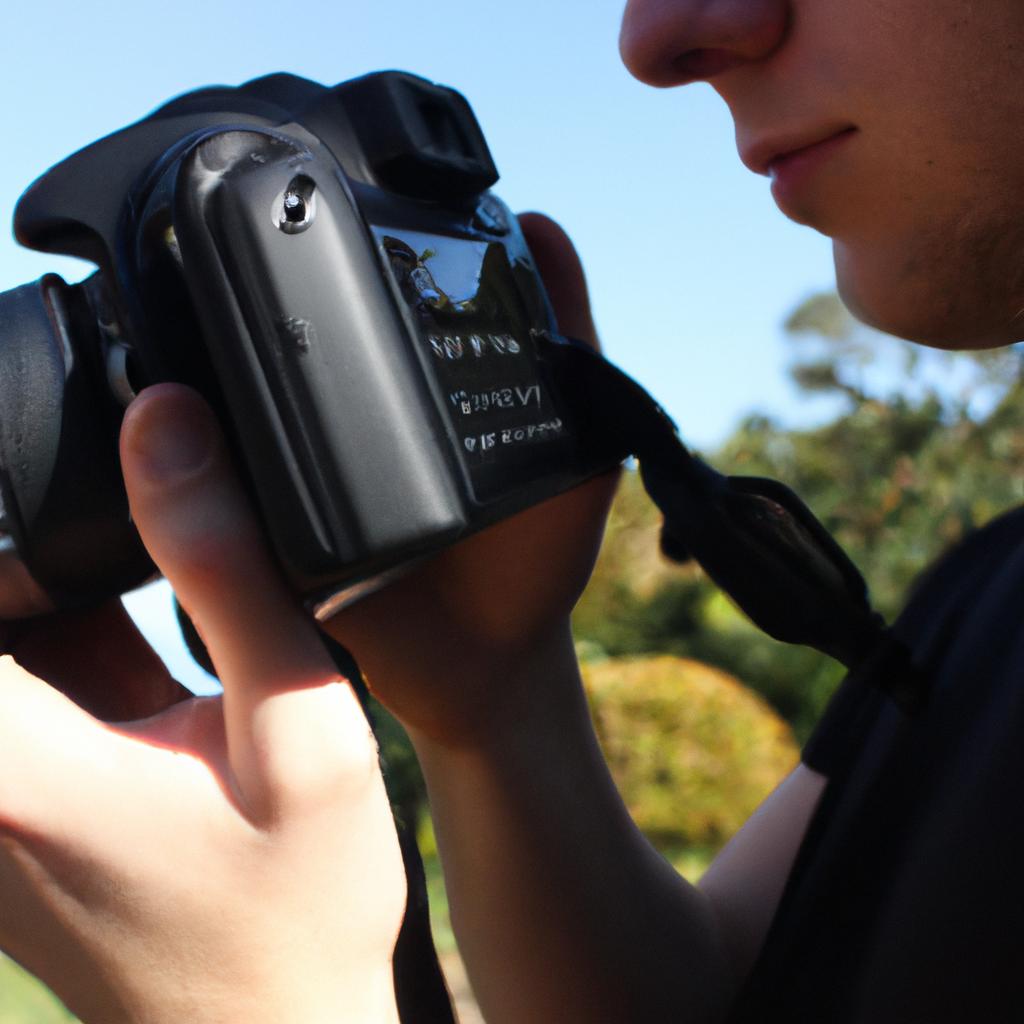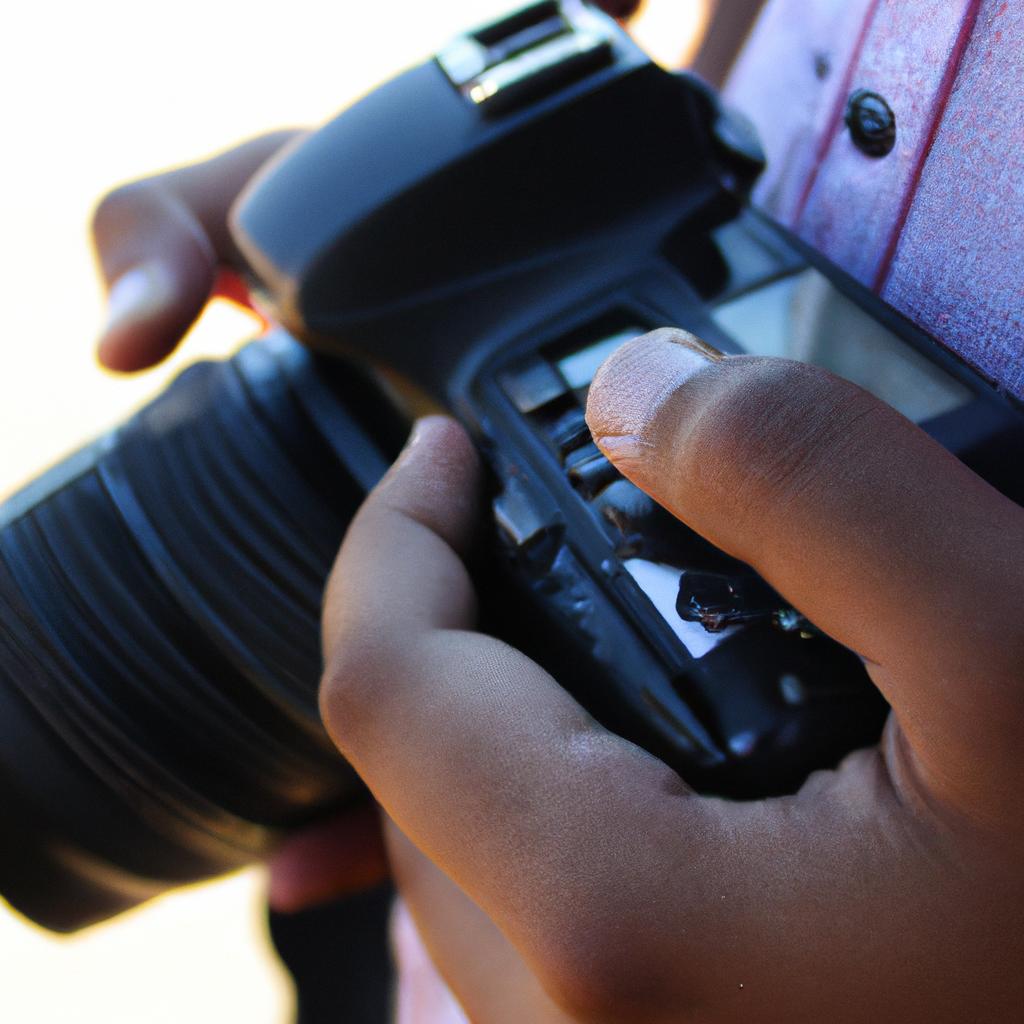Color temperature plays a vital role in photography, as it directly affects the overall mood and atmosphere of an image. Understanding how color temperature works is crucial for photographers who aim to capture scenes accurately and convey specific emotions through their photographs. For instance, imagine a landscape photographer setting out early in the morning to capture the sunrise over a serene lake. To accurately represent the tranquility and warmth of this moment, the photographer must consider the color temperature and adjust the white balance accordingly.
In technical terms, color temperature refers to the measurement of light’s warmth or coolness emitted by various light sources. It is measured on the Kelvin scale, with lower values representing warmer (more yellowish) tones and higher values indicating cooler (more bluish) tones. The concept of color temperature becomes particularly important when considering white balance in photography – which involves adjusting camera settings to ensure that whites appear true-to-life without any unwanted color casts. By manipulating white balance based on color temperature considerations, photographers can enhance certain attributes within an image or create intentional effects that evoke particular emotions from viewers.
Understanding color temperature and its impact on white balance allows photographers to harness their artistic vision effectively. This article aims to delve into the intricacies of color temperature, exploring how different lighting conditions affect our perception of color and how photographers can use this knowledge to create compelling images.
Firstly, it’s essential to understand that our eyes naturally adapt to different lighting conditions, perceiving colors differently based on the dominant light source. For example, midday sunlight has a higher color temperature (around 5500K), resulting in cooler tones with a bluish cast. On the other hand, indoor lighting often has a lower color temperature (around 2700-3000K), creating warmer tones with a yellow or orange hue.
When photographing under different lighting conditions, it is crucial for photographers to adjust their camera’s white balance settings to compensate for these variations. White balance helps ensure that whites appear neutral and that other colors are rendered accurately. By setting the appropriate white balance, photographers can prevent unwanted color casts and achieve more faithful representations of their subjects.
In addition to accurate color reproduction, understanding color temperature enables photographers to manipulate the mood and atmosphere of their images intentionally. Cooler temperatures tend to evoke feelings of calmness, serenity, or even sadness. Think of photographs capturing snowy landscapes or moonlit scenes by the ocean. The blueish hues created by higher color temperatures enhance these emotions.
On the other hand, warmer temperatures convey a sense of warmth, comfort, or energy. Photographs taken during golden hour – the period shortly after sunrise or before sunset – often exhibit warm tones that evoke feelings of nostalgia and romance.
By deliberately adjusting white balance settings or using filters during post-processing, photographers can enhance these emotional cues further. For instance, adding a warming filter during editing can intensify the cozy feeling in an image taken during golden hour or exaggerate the fiery glow of a sunset.
Understanding color temperature also allows photographers to experiment creatively. They can play with contrasting elements by incorporating warm and cool tones within a single frame. This technique adds visual interest and depth to photographs while inviting viewers’ attention to specific areas or subjects within an image.
In conclusion, color temperature plays a critical role in photography, affecting the mood and atmosphere of images. By understanding how different lighting conditions influence color perception and adjusting white balance accordingly, photographers can accurately reproduce colors and convey specific emotions in their photographs. Moreover, by manipulating color temperature creatively, photographers can enhance or transform the visual impact of their images to captivate viewers’ attention and evoke emotional responses.
Color temperature and its significance in photography
Color temperature is a fundamental concept in photography that plays a crucial role in determining the overall mood and visual impact of an image. By understanding color temperature, photographers can effectively manipulate white balance to achieve desired results.
To illustrate the significance of color temperature, let’s consider a hypothetical scenario. Imagine capturing a photograph of a tranquil beach at sunset. The warm hues of orange and pink create a serene atmosphere, evoking feelings of relaxation and contentment. Now, imagine taking the same photograph with cool blue tones dominating the scene instead. Suddenly, the calmness dissipates, and the image feels cold and distant. This stark contrast demonstrates how color temperature influences our perception and emotional response to an image.
In order to grasp this concept further, it is important to explore some key aspects related to color temperature:
- Emotional Impact: Different colors elicit distinct emotions within us. Warm colors like reds, oranges, and yellows tend to convey warmth, energy, and passion. Cool colors such as blues and greens evoke tranquility, serenity, or even sadness.
- Cultural Associations: Colors may also carry cultural connotations that influence our interpretation of an image. For example, red is often associated with luck or celebration in many Asian cultures while white symbolizes purity or innocence in Western societies.
- Color Harmonies: Understanding how different colors interact with each other is essential for creating harmonious compositions. Complementary colors (opposite on the color wheel) provide dynamic contrasts, while analogous colors (adjacent on the color wheel) offer more subtle blends.
- Psychological Effects: Certain shades can have psychological effects on viewers. For instance, studies suggest that people tend to perceive cooler-toned images as more spacious or expansive compared to warmer-toned ones.
By incorporating these elements into their work through careful consideration of color temperature choices, photographers can guide viewer perceptions and enhance visual storytelling capabilities.
Looking ahead towards understanding the Kelvin scale for measuring color temperature, we delve into the technicalities of how this measurement system quantifies different colors and provides a standardized reference point for photographers to achieve accurate white balance.
Understanding the Kelvin scale for measuring color temperature
Color temperature is a fundamental aspect of photography that greatly impacts the overall look and feel of an image. By understanding the concept of color temperature, photographers can effectively manipulate white balance to achieve their desired aesthetic. In this section, we will delve into the Kelvin scale, which is used to measure color temperature in photography.
To illustrate the significance of color temperature, let’s consider a hypothetical scenario: imagine a landscape photograph taken during sunset. The warm hues of orange and red dominate the scene, creating a sense of warmth and tranquility. This warmth is attributed to the higher color temperature associated with sunlight during golden hour. On the other hand, if the same landscape were captured under fluorescent lighting indoors, it would appear cooler due to its lower color temperature.
Understanding how color temperature affects photographs allows photographers to effectively convey specific emotions or moods through their images. Here are some key points regarding color temperature:
- Warm colors (higher temperatures) such as reds, oranges, and yellows tend to evoke feelings of comfort, intimacy, and energy.
- Cool colors (lower temperatures) like blues and greens create a sense of calmness, serenity, and distance.
- Temperature shifts can be utilized creatively by adjusting white balance settings or making post-processing adjustments.
- Different light sources have varying color temperatures; for instance, incandescent bulbs emit warmer light compared to fluorescent lights.
To further comprehend these concepts visually, let’s take a look at the following table showcasing typical associations between color temperatures and corresponding emotional responses:
| Color Temperature | Emotional Response |
|---|---|
| 2000K – 3000K | Cozy |
| 4000K – 5000K | Neutral |
| 6000K – 7000K | Cold |
| Above 8000K | Sterile |
As we enter our discussion on “The impact of warm and cool colors on the mood of a photograph,” it is important to remember that color temperature plays a pivotal role in conveying emotions and setting the tone for an image. By skillfully manipulating white balance settings or making post-processing adjustments, photographers can effectively evoke specific responses from their audience.
The impact of warm and cool colors on the mood of a photograph
Understanding the Kelvin scale for measuring color temperature helps photographers achieve accurate white balance in their photographs. By adjusting the white balance, they can ensure that colors appear as intended and convey the desired mood or atmosphere. In this section, we will explore the impact of warm and cool colors on the mood of a photograph.
To illustrate the importance of color temperature in setting the mood, let’s consider a hypothetical example: Imagine a landscape photograph taken during golden hour at sunset. The warm hues created by the sunlight cast an enchanting glow over the scene, evoking feelings of tranquility and warmth. Now imagine if the photographer had used a cooler white balance setting, resulting in bluer tones dominating the image. The entire mood would shift, transforming it into a colder and perhaps less inviting scene.
When considering warm and cool colors in photography, it is essential to understand how different temperatures influence emotions. Warm colors such as reds, oranges, and yellows tend to evoke feelings of energy, passion, happiness, and excitement. On the other hand, cool colors like blues and greens often create a sense of calmness, serenity, sadness or isolation.
To further emphasize these emotional responses within our photographs using color temperature effectively:
- Use warmer tones when seeking to portray joyfulness or vibrancy.
- Opt for cooler hues to convey peacefulness or melancholy.
- Experiment with complementary warm-cool color combinations to create visual contrast.
- Consider cultural associations with certain colors; some cultures may have specific meanings attached to particular shades.
| Warm Colors | Cool Colors |
|---|---|
| Reds | Blues |
| Oranges | Greens |
| Yellows | Purples |
By understanding how warm and cool colors affect viewer perception emotionally, photographers can intentionally manipulate color temperatures to elicit specific reactions from their audience. In turn, this allows them to craft images that effectively communicate their intended message or narrative.
Transitioning smoothly to the next section, we will now explore the practical aspect of choosing the appropriate white balance setting for different lighting conditions. Understanding how color temperature impacts mood is crucial, but it is equally important to apply this knowledge effectively in real-world scenarios.
Choosing the appropriate white balance setting for different lighting conditions
The impact of warm and cool colors on the mood of a photograph can be significant, eliciting different emotional responses from viewers. Understanding color temperature in photography is crucial for achieving the desired mood and atmosphere in an image. In this section, we will explore how photographers can choose the appropriate white balance setting for different lighting conditions.
To illustrate this concept, let’s consider a hypothetical scenario where a photographer is capturing images during sunset at a beach. The warm hues of the setting sun create a serene and romantic ambiance that enhances the overall feeling of tranquility in the photographs. By adjusting the white balance to a warmer setting, such as using the “Cloudy” or “Shade” preset, the photographer can amplify these warm tones and intensify the emotions evoked by the scene.
When selecting the appropriate white balance setting for different lighting conditions, there are several factors to consider:
- Natural light: Depending on whether you are shooting outdoors under sunlight or indoors with daylight coming through windows, it is essential to adapt your white balance settings accordingly.
- Artificial light sources: Different types of artificial lights emit varying color temperatures. Adjusting your camera’s white balance according to these sources will help maintain accurate colors in your photographs.
- Mixed lighting situations: Sometimes, you may encounter scenarios where multiple light sources with different color temperatures coexist within a single frame. Experimentation with white balance presets or manual adjustments becomes necessary in such cases.
- Creative choices: Remember that white balance is not solely about reproducing accurate colors but also about artistic expression. Don’t hesitate to experiment with different settings to achieve unique visual effects and evoke specific emotions.
Overall, understanding how color temperature influences photography allows photographers to manipulate moods effectively and convey their intended messages through visuals alone.
Now let’s delve into common challenges faced when adjusting color temperature in post-processing, where precise control over white balance becomes imperative for achieving desired results.
Common challenges faced when adjusting color temperature in post-processing
Imagine you have just finished a photoshoot, capturing stunning images under varying lighting conditions. Now, as you sit down to edit your photographs, one of the crucial aspects you need to address is adjusting their color temperature. However, this process can present several challenges that photographers often encounter during post-processing.
One common challenge is dealing with mixed lighting scenarios. In certain situations, such as indoor venues or street photography at night, different light sources may be present simultaneously. This can result in a combination of warm and cool tones within the same image. Achieving an accurate white balance becomes particularly challenging when faced with conflicting color temperatures from these diverse light sources.
Another issue arises when attempting to correct extreme color casts caused by unconventional lighting setups or environmental factors. For instance, capturing photographs near bodies of water, where reflections can introduce intense blue hues into the scene, requires careful adjustment to ensure accurate representation of colors.
Additionally, working with JPEG files instead of RAW images presents its own set of challenges. JPEGs are compressed and processed versions of the original raw data captured by the camera’s sensor. Consequently, they offer limited flexibility for correcting color temperature compared to RAW files that retain more information. Editing JPEGs excessively could lead to loss of detail and negatively impact overall image quality.
To further understand some emotional effects experienced by photographers facing these challenges in adjusting color temperature during post-processing:
- Frustration: Constantly striving for precise color reproduction but encountering difficulties due to complex lighting conditions.
- Satisfaction: Successfully overcoming hurdles associated with mixed lighting scenarios and achieving harmonious color balance.
- Creative satisfaction: Discovering unique ways to incorporate unconventional lighting casts into artistic compositions.
- Professionalism: Demonstrating expertise by skillfully manipulating color temperature even when using less flexible file formats like JPEG.
Consider the following table illustrating various emotions photographers might experience while grappling with these challenges:
| Emotion | Example Scenario |
|---|---|
| Frustration | Struggling to correct color casts in street photography at night |
| Satisfaction | Successfully balancing warm and cool tones in an indoor photoshoot |
| Creative satisfaction | Incorporating reflections from bodies of water into a composition |
| Professionalism | Accurately adjusting color temperature despite working with JPEGs |
In overcoming these challenges, photographers can ensure their images accurately represent the intended colors. The subsequent section will provide valuable tips for achieving accurate color reproduction in your photographs.
[Transition sentence] Now, let’s explore some effective techniques for achieving accurate color reproduction in your photographs.Tips for achieving accurate color reproduction in your photographs
Understanding the common challenges photographers face while adjusting color temperature in post-processing is crucial for achieving accurate and visually appealing images. By addressing these obstacles head-on, photographers can enhance their skills and produce high-quality photographs that accurately represent the scene they captured. Let us explore some effective tips to overcome these challenges.
Section:
- Utilize reference points:
To ensure accurate color reproduction, it can be helpful to have reference points during the editing process. One way to achieve this is by including a neutral gray card or using an object with known colors within the frame of your photograph. By having a point of comparison, you can easily adjust white balance settings and make precise corrections based on true-to-life colors.
- Example: Consider a landscape photographer capturing a sunset scene with vibrant reds and oranges. To maintain accuracy, they include a small white flower in the foreground. This serves as a reference point to help adjust the color temperature during post-processing.
- Experiment with different presets:
Post-processing software often provides various preset options for white balance adjustments. These presets are designed to mimic lighting conditions such as daylight, shade, cloudy weather, tungsten light, etc. By experimenting with these presets, photographers can quickly identify which setting best matches their intended mood or atmosphere for the image.
- Emotional bullet point list (markdown format):
- Presets allow for effortless experimentation.
- Discovering the perfect match enhances visual impact.
- Achieving desired emotions through accurate color representation.
- Connecting with viewers on an emotional level through harmonious hues.
3-column x 4-row table (markdown format):
| Challenge | Solution | Benefits |
|---|---|---|
| Mixed lighting sources | Use custom white balance settings | Consistent color representation |
| Inaccurate ambient light | Adjust white balance in RAW files | Preserve true colors and details |
| Creative control | Experiment with tint adjustments | Enhance the mood or atmosphere of an image |
| Complex scenes | Target specific areas for correction | Maintain accurate color portrayal |
- Calibrate your monitor:
A calibrated monitor is essential to accurately visualize the colors during post-processing. Without proper calibration, the colors displayed on your screen may appear different from their actual values. By using specialized hardware or software tools, photographers can ensure that what they see on their monitors aligns with industry standards, resulting in more consistent and reliable color reproduction.
By implementing these tips, photographers can overcome common challenges associated with adjusting color temperature during post-processing. Utilizing reference points, experimenting with presets, and calibrating one’s monitor all contribute to achieving accurate and visually captivating images. With a keen eye for detail and a commitment to refining one’s techniques, photographers can consistently produce photographs that resonate emotionally with viewers around the world.
Please let me know if you need any further assistance!
 Reklami
Reklami



